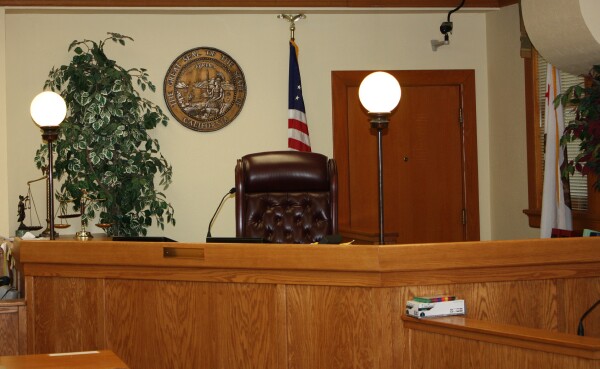
However, Mr. Ruiz was charged for his involvement with four felonies, including burglary, petty theft, and two conspiracy charges. On Wednesday a Yolo County jury found him guilty on all four courts and now Mr. Ruiz could face up to three years in prison for someone else stealing less than $200 worth of merchandise.
The store security said he became suspicious when the woman asked for two of the exact same stereo. He let his partner know and his partner upon seeing the woman told him that she was a known shoplifter and they had apprehended her four months prior.
The defense countered that this was Ms. Dougherty’s crime not Mr. Ruiz. Mr. Ruiz came into Wal Mart, bought his merchandise legally, paid for it with cash, left the store and went to his car. Ms. Ruiz then left her merchandise in the store, came out to the car, took his bag and receipt. She went in and tried to get a new set of items and pass them off to the greeter as though she had just purchased them herself.
The two store security officials told a very different story at a critical point. Mr. Ruiz had gone around and picked out a stereo, but apparently there was only one stereo on the floor. One of the security officials said that Ms. Dougherty went to a clerk, asked for an identical stereo, the clerk came back with that stereo. He said that he did not see Mr. Ruiz there and did not know how the second stereo got to Mr. Ruiz.
However, the other store security official gave a different story. He said the two came to the store clerk together, they showed the clerk a tag, and asked for two stereos. So in one story, the two came up together, in the other version it was only Ms. Dougherty. To explain the discrepancy there were two explanations offered, one that the two security officials had different vantage points and the other that there was a good amount of passage of time. However, the second security official was asked to verify the police report made by the first one, this was done at the time of the arrest and he said that is how it happened.
The video played a key part in the conviction. This despite the fact that the video itself did not show much. It should the individuals pointing at merchandise and talking. The prosecution argued this showed collaboration, the element needed for the conspiracy crime to be sustained. The defense argued that it was ambiguous and they could have been talking about anything.
However, a critical factor was the time element. They were in the store for some time trying to find the merchandise. When Mr. Ruiz finally purchased the merchandise he went out to his car. Ms. Dougherty apparently left her cart with the items. She walked outside to the car. Mr. Ruiz drives his car to the entrance. Ms. Dougherty is seen emerging from the car with a bag. She re-enters the store. That takes six minutes in total.
She goes to her cart, realizes that she had brought the Wii back with her and so she discards the second Wii, walks back to the door. She pulls the receipt out of her pocket (which is key evidence for the prosecution) and heads for the exit. At this point, the two security officials who had been watching and following her, rush her, and apprehend her.
For the prosecution, the small window of time in which this all occurs is key evidence of a conspiracy. However, the defense argues this is all circumstantial and that we have no idea what was said and that we have no evidence that Mr. Ruiz knew what Ms. Dougherty would be doing.
As the DA put it however, Ms. Dougherty is walking out the door of the car that he had pulled up to the front with his property, he would have seen the bag, moreover, we know she pocketed the receipt and must have done it in the car since she was never seen putting it in her pocket in the store.
Clearly the jury agreed with this version of events, but to me it is not quite so clear. To me the key question is not whether Mr. Ruise knew Ms. Dougherty was exiting the vehicle with a bag, containing some of his purchased merchandise and the receipt, the key question is whether he knew what she was going to do with this.
The prosecutor argues time is a key factor. But time is elusive. It is not like she was under the gun with time. She simply went out to the car and came back. How long would that take? It is hard to say.
We are not privy to the conversation between the two people inside the car so we can only speculate. In terms of reasonable doubt, the standard is that if there are competing reasonable explanations the jury needs to pick the one that ends with a not-guilty showing. There is never any direct evidence shown of a conspiracy.
The two could have gone in to get the stereo and Ms. Dougherty could have told Mr. Ruiz that she thought it was too expensive. They could have discussed it back and forth and she finally told him that she had decided to leave it. Once they reached the car she could have said she had changed her mind or she could have said, oh we got something that we were weren’t suppose to. Bottom line, there is no way for the jury or us to know what was discussed in the car. It was possible that they had a plan, it is possible that he had no idea other than she was going back in the story to deal with something.
Toward that end, he was apprehended in the parking lot thirty minutes later. If he was really involved in a plot, would he have waited after it was obvious she must have been caught?
Moreover, why plot that way to begin with. If their plan was to pull this off, have one go in, get two of each products, set one set aside and have the other come in, pick up the car and put the items in the bag. Having the individual be unfamiliar would have been a better plan. Obviously, the idea could have been poorly formed and conceived of, that is not evidence of Mr. Ruise’s ultimate innocence.
But forget about the question of guilt and innocence for a moment. This case still comes down to about $150 in merchandise taken from the store. Even if he did all that they said does that warrant any felonies let alone four of them? Regardless of the issue of reasonable doubt, and I believe there is considerable evidence to point to reasonable doubt here – we simply do not know if he did it or not – the charges do not seem to fit the crime.
Give him a misdemeanor, put him on probation and make him do community service. It makes a lot more sense than the state having to potentially pay over $100,000 to house him in prison, if Judge Warriner decides to go that route.
This is simply another example of the DA’s office over-charging someone with four felonies for a very minor crime.
—David M. Greenwald reporting





I think the actions of these individuals seem pretty suspicious.
I do agree that they should have been charged with misdemeanors. I don’t understand the DA’s strategy of over charging people. Four felonies doesn’t make sense in this case.
Why does the DA choose to charge felonies for misdemeanor crimes?
” Ms. Dougherty was arrested and she eventually plead no contest to her role in the case.”
So is she facing the same penalty? or something less?
dmg: “But forget about the question of guilt and innocence for a moment.”
I’m assuming from this statement you are conceding it was not unreasonable for the jury to find both defendants guilty as charged.
dmg: “However, Mr. Ruiz was charged for his involvement with four felonies, including burglary, petty theft, and two conspiracy charges. On Wednesday a Yolo County jury found him guilty on all four courts and now Mr. Ruiz could face up to three years in prison for someone else stealing less than $200 worth of merchandise.”
From website on subject of felonies: “Felonies include nonviolent crimes like petty theft (shoplifting) WITH A PRIOR CONVICTION, to more violent crimes such as domestic violence, assault with a deadly weapon, robbery, sex crimes and murder.” I assume then that the defendant had one or more prior convictions for shoplifting, and is probably the reason this was charged as a felony rather than a misdemeanor.
Another wrinkle is that the defendant in this case seems to have chosen to refuse a plea bargain, putting the state to the expense of putting on a trial. And as we know, the DA will throw the book at defendants who refuse to take plea deals, to deter future defendants from following suit and refusing plea deals offered by the DA.
Yeah, with no priors seems like a fine and some community service is more appropriate.
With prior convictions, maybe a couple of months in the county jail; but certainly not several years in the state pen for shoplifting conspiracy & related charges (might Ruiz be sentenced to a state pen?).
Energy & resources would seem be better spent tracking down and apprehending the really bad guys instead!
A DDA from San Mateo County told me they never charge anyone with conspiracy to commit a misdimeanor (a felony) – they view the charge as a “joke”. Yet in Yolo County it is used twice in the same case.
He had no priors for shoplifting or theft.
Alphonoso: they were charged with the same things, I don’t know what she plead to.
“I’m assuming from this statement you are conceding it was not unreasonable for the jury to find both defendants guilty as charged.”
It’s a judgment call. I think there was burden shifting in this case, however, as FAI said, it looks suspicious.
jimt: if you look at the sentences for each penalty, you come up with 3 to 4 years in prison. These is some discretion here by the judge and he could suspend parts of the sentences, but it is Judge Warriner.
dmg: “He had no priors for shoplifting or theft.”
erm: “Another wrinkle is that the defendant in this case seems to have chosen to refuse a plea bargain, putting the state to the expense of putting on a trial. And as we know, the DA will throw the book at defendants who refuse to take plea deals, to deter future defendants from following suit and refusing plea deals offered by the DA.”
I have to assume “deterrence” was the reason for charging a felony, to “encourage” future defendants to plea bargain.
Alphonso: “A DDA from San Mateo County told me they never charge anyone with conspiracy to commit a misdimeanor (a felony) – they view the charge as a “joke”. Yet in Yolo County it is used twice in the same case.”
This defendant was charged with a felony…?????????
“This defendant was charged with a felony…????????? “
I admit I am a little confused by the charges. I have this notion that petty theft is a misdomeanor, but conspiracy to commit petty theft is a felony. I am assuming a couple of these felonies were actually based on “conpiracies to commit misdomeanors”. That was the basis of my comment.
I guess when you look at this case it helps to understand a bit about the law.
The penal code for burglary is 459 PC, every person who enters any store with intent to commit grand or petty larceny or any felony is guilty of burglary.
The penal code defining a principal to a crime is 31 PC, all persons concerned in the commission of a crime, whether it be felony or misdemeanor, and whether they directly commit the act
constituting the offense, or aid and abet in its commission, or, not
being present, have advised and encouraged its commission, for the purpose of causing him to commit any crime are principals in any crime so committed.
The penal code for conspiracy is PC 182. (a) If two or more persons conspire:sad:1) To commit any crime. The rest is a long read but the section only talks about felonies.
I had to cut a bunch of junk out for the sake of length.
So you have two people on video comparing merchandise, asking for identical stereos. She ends up with the receipt and the bag. She goes back and ends up with the merchandise they had both been talking about. She gets caught and is recognized as a thief from a prior shoplifting beef.
On a side note the receipt/merchandise scam is a huge loss to stores and requires some planning. It appears in this case it took two people to come up with the plan.
Had Mr Ruiz never goon in the store the first time I would by that is is just a victim of circumstance here. Fortunately the jury have grasp of beyond a REASONABLE doubt.
It looks to me like they had a plan and executed it. You can almost always cast SOME doubt, it just has to be reasonable.